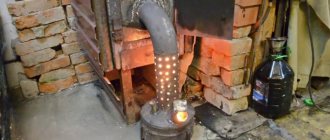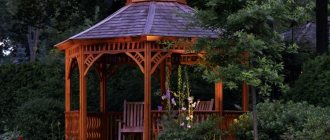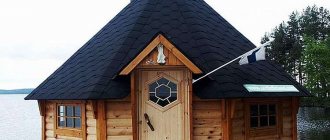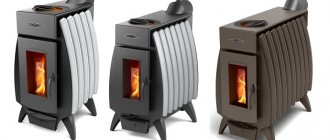A suburban area or cottage will be perfectly complemented by a gazebo equipped with a barbecue. It is simply irreplaceable for lovers of outdoor recreation and food cooked over an open fire.
The grill area inside the gazebo can be equipped with:
- stone stove with cast iron cauldron;
- portable or stationary barbecue, grill or barbecue;
- a fireplace, which is usually equipped on a glazed terrace.
The choice of type of gazebo depends on the material of manufacture, landscape design of the site, and the preferences of the owner. Structures must fit harmoniously into the overall style of the house and garden.
The materials most often used to build gazebos with barbecues or barbecues are:
- stone or brick;
- wood (timber, log, board);
- rolled metal
Photo: combined version - made of timber and stone. The roof is covered with polycarbonate.
Features of gazebos with a stove
A summer kitchen with a barbecue or barbecue can be either closed or open.
The advantage of the first is the possibility of year-round stay. This is advisable if the owners often visit their dacha or live in a private house. Otherwise, it is better to give preference to a summer open kitchen. It costs less, is easier to build, looks more compact and does not require special permits. Tree
Environmentally friendly, natural material that will never lose its relevance. The design of such gazebos is always pleasing to the eye, looks natural and light, fits well into the natural landscape and is in harmony with the surrounding nature. You can install the summer structure yourself, since there is no need for a heavy-duty foundation, and the wood is easily fastened with metal corners.
However, such gazebos also have a lot of disadvantages. Every 5–6 years, the facade needs to be updated, since the wood is deformed due to moisture, precipitation, and sudden temperature changes. Cracks and unevenness may form on the surface, and the wall may become askew. The wood must be treated with a special solution to protect against pests. Varnishing will provide protection from the negative influence of external factors.
But thanks to the collapsible tent structures presented on the website https://fullerdome.com/sale-geodesic-structures, you can comfortably hold various events outside the city in the open air at any time of the year and in any weather conditions.
Brick
This is a durable and very wear-resistant material. It costs more than all the others, but its service life is much longer. It withstands temperature changes, cold and heat, does not deform or lose shape. Unlike wood, it does not ignite, does not form fungus or mold, and is not attractive to pests. Brick is also thermally insulating, so it retains heat in cold weather and, on the contrary, cools in hot weather.
As for installation, it is impossible to build such a gazebo yourself without similar construction experience. Here you will need to install a strip-type foundation, strong and reliable, so that the building does not sink into the ground and is firmly fixed, despite its impressive weight. But, having invested money once, you will no longer have to think about restorations and return to repairs.
Metal
The material itself is used to create frames and as a base. Monolithic structures are not made of metal, since it quickly heats up in the summer and becomes icy in the cold of winter. But forged elements for an open summer gazebo with a kitchen or barbecue are very suitable and will make the interior elegant and expensive. It is imperative to treat the surfaces with an anti-corrosion solution so that the metal retains its attractive appearance. Metal elements go well with stone, brick and wood, so the design can be played out in different styles. If we are simply talking about a metal frame with a roof, it is recommended to exclude plastic furniture, since it does not fit into such an interior.
For those who are planning to install a stove in a ready-made gazebo, additional costs and possible changes in the appearance of the structure should be considered. Installation of the structure is a complex and time-consuming process that will require the help of professional specialists, since in some cases it is necessary to remove the floor covering to strengthen the foundation. To save the family budget, you can replace the stationary model with a portable one. Such a kitchen with a barbecue will be better in functionality, but the costs will be lower.
Selecting a location
A few nuances for choosing a suitable site for a gazebo with a stove.
The structure should not be located near gas pipes or electrical lines. Such close proximity is unsafe. The best choice would be a place under trees: a thick crown can reliably protect the building from the sun's rays on a hot day.
The structure should not be located next to a cesspool, outbuildings, pigsties, chicken coops, etc. buildings. The gazebo is designed for relaxation, so find the most beautiful place possible for it.
It is also undesirable to locate a building near a passing noisy highway or a dusty village road. Rising clouds of dust from passing vehicles can seriously ruin the mood of you and your guests. In addition, dust will get into the food. It will also be interesting to learn about how to add a gazebo to your house.
In the video - choosing a place for a gazebo:
You should not build a gazebo in a place where you are used to constantly walking and moving. In this case, a building that appears in the middle of a familiar path will become an annoying inconvenience.
If you place a gazebo with a stationary stove near the house, it will be easier to connect communications to it. Make sure that smoke from food is not directed towards the house.
Construction
The dimensions of the stationary stove are small, so the amount of material for manufacturing will be required.
You can use the standard scheme:
- ordinary brick - 360 pieces;
- fireclay bricks – 120 pieces;
In addition, you will need a solution of clay and sand
At the same time, it is important to note a nuance: the mortar intended for brickwork must be of a consistency that will prevent it from sticking to the tool, but at the same time will not allow it to spread over the surface of the brickwork. Construction stages are directly related to the type of structure chosen
Foundation
When constructing a stove and a gazebo at the same time, the foundation under these two structures can be single. When installing a stove in a finished gazebo, you need to choose the right place. The principles of arrangement are usually common to the arrangement of a fireplace.
For example, the absence of drafts and safety are important
A pit is dug under the base, the depth of which should be 50-60 cm. Gravel is laid at the bottom of the pit and compacted. The next stage is reinforcement; you need to make a wire mesh and install formwork along the edges. Next, fill the hole with concrete to a level below 5 cm from the floor.
Leave to harden, depending on weather conditions, for approximately 20-25 days. To prevent the occurrence of chips, it is recommended to moisten the hardening concrete with water. After the hardening period has expired, apply waterproofing (for example, roofing felt). The next mandatory step is the construction of the stand.
Construction
The stand is laid taking into account the order drawing. Hollow brick is suitable as a material. If the work is done with your own hands, you should take into account the dressing, checking the evenness of the rows and corners with a level
Pay special attention to the first six rows of the order. They will be a place for shelves under the countertop
7th row – covering the hearth, 8th row – dressing the overlap and the beginning of the bottom of the firebox.
Firebox
When performing the 9th row, you can use fireclay
When lining, the main attention should be paid to the thickness of the solution: it should not be more than 3 mm. To ensure thermal expansion of this type of brick, the transition between the two types must be at least 20 mm
If there is no transition, the fireclay will crack during use and the firebox will become deformed.
The temperature gap is laid out with a basalt cord. It is non-flammable and has thermal insulation properties. The 10th row is a continuation of the furnace row with simultaneous narrowing. 11th row - completion of the firebox laying. Here you can already install the grate (grid-irons).
brazier
The roasting pan is formed starting from the 12th row (from a ledge of one brick under the skewer). The space of the roasting pan should be laid out from rows 13 to 16. The formation of the walls is completed on the 17th row.
Vault
If you have little experience in arranging stoves, then it is better to form the vault using a template prepared from cardboard. The template needs to be drawn onto the bricks, marking the points with a marker. According to the exposed marks, the brick is subsequently cut, forming a vault. For better stability, you can make a mandrel from solid wood. You can remove it after the solution has completely dried.
Next, a chimney pipe is erected. Consider insulating the structure at the point of contact with the roof of the gazebo. Insulate the floor near the stove, insulate the walls and ceiling. The installation stage of the hood and chimney can be simplified, since the components can be purchased ready-made. Instead of bricks, sheet metal can be used at this stage.
As soon as the masonry is formed, you can arrange the cutting table. The countertop must match the size of the brickwork. Wood, stone slab, multi-layer plywood and cast iron can be used as countertop materials. The latter option can act as a built-in hob on which you can cook food.
We build a stove in a gazebo with our own hands
List of required materials and laying the foundation Technology for constructing a stove for a gazebo
A gazebo with a built-in stove allows you to cook kebabs (and more) at any time of the year and in bad weather. No rain prevents you from spending time with family or friends in the fresh air, away from city smog and noise. Contemplation of a stove flame helps to relax and gives an atmosphere of warmth and comfort. Today you can order a stove for a gazebo from a construction company, but building it yourself will cost a much smaller amount. It is enough to purchase the necessary materials and have the desire to build it. And, of course, follow clear construction instructions.
A barbecue gazebo creates a feeling of homeliness, comfort and tranquility. Such a gazebo can easily become a summer kitchen and dining room for family tea parties and celebrations.
A stove for a gazebo must meet many safety requirements.
Firstly, it cannot be erected close to the wall of the gazebo, since even fire-resistant brick gets very hot. Secondly, it is necessary to trim the lower branches of trees (and, if possible, not place the stove in close proximity to them) to eliminate the possibility of fire.
Even before construction, you need to think about the design of the stove and its location: you need to build the gazebo in such a way that the smoke does not reach the house, and even more so the people relaxing in the gazebo. With your own hands you can build both a stove of a traditional design and a modern stove. It all depends on your taste preferences and the general landscape of the adjacent territory. Stoves also come in simple (fireplace stove) and complex (with hood and blower) designs. Again, it all depends on the taste of the owners and the amount of material costs that will be needed to purchase the necessary materials. List of required materials and laying the foundation
If you decide to build a stove with your own hands, you will need the following materials:
fire brick;
ordinary facing brick; roofing felt; boards for formwork; boards for tabletops; cement mortar; any metal scraps (pieces of reinforcement, wire, pieces of channel will do); metal pipe; faucet and sink (if provided); water hoses.
This list is not exhaustive and some other materials will be used at your discretion.
To prevent the structure from being skewed in the future, you need to approach the construction of the foundation with your own hands responsibly. Its construction work is being carried out in stages:
Remove the floor covering of the gazebo in the selected area for construction and mark it using pegs and rope. Dig a hole for the foundation (usually 30 cm is enough) and make a carefully compacted bed of slag. The depth of the hole along the entire perimeter must be strictly the same. Install formwork made of uncut wooden boards (about 30 cm thick) around the entire perimeter of the pit and pour reinforcement into it. The pit is filled with M100 cement mortar so that no pieces of metal stick out and the surface is absolutely flat. The cement mortar is poured at a time: this ensures the high strength of the monolithic foundation. After the concrete screed has dried, which takes 3-4 days, it is covered with roofing felt.
As mentioned above, you can build both simple and complex stoves with your own hands. The simplest design is the stove with the letter “P”. It is erected on a concrete foundation made of refractory bricks, which is held together with a mortar of clay and cement in a ratio of 1:3. Water is added to the solution until its consistency resembles thick sour cream. The optimal height of such a stove is m. When laying walls, metal mesh is installed between two parallel walls, at a distance of about 25 cm from each other. A chimney is installed above the grates. Thus, the fire burns on the lower part, and the food is cooked on the upper part. Since the oven is small, you can build it with your own hands in a few days.
The second version of the stove is much more complicated. Its design resembles the letter "E". The lower masonry is made of gas silicate brick, and it serves as a woodpile. The upper part is built only from refractory bricks; it is the combustion part. If a sink and faucet, a countertop and built-in storage space for dishes are provided, then you should think about their placement even before construction begins: it is very difficult to make any adjustments during the work.
It is better to build a stove for a gazebo with your own hands according to diagrams and drawings, and if you wish, you can develop your own unique design.
A stove in a gazebo, made technically correctly and accurately, will become a favorite place for relaxation for the owners and their guests.
Video description
You can see the entire process of constructing the furnace in the video:
- The most critical stage of work is laying the brazier . It is advisable to use the most heat-resistant brick (fireclay) for it. Ceramic or clinker bricks are used to build the rest of the structure.
- If necessary, a canopy, a chimney , an extractor hood is installed, a sink is installed with the necessary communications connected.
- The final stage is decorative finishing . It is necessary in the case when rough brick was used during construction, and it is necessary to improve the appearance. Finishing can be done using artificial and natural stone, porcelain stoneware, facing tiles, terracotta.
Stone finishing is a classic that always looks just great Source yandex.uz
The main stages of manufacturing a stove for a gazebo
Before building a stove complex for a gazebo, projects of which are widely presented on the Internet, it is recommended to choose experienced specialists. In addition, to create a furnace you will need refractory bricks, a foundation, metal structures for the chimney, firebox and finishing of the adjacent surface. The elements are connected with heat-resistant glue, the outer surface is finished with varnish.
Most modern stoves are not lined, allowing owners to enjoy the natural beauty of brick Source materialexpert.ru
Construction of the furnace
The first stage is preparing the foundation on the selected site. The more massive and functional the future installation, the more reliable this design should be. Builders dig a pit up to half a meter deep, in which a reinforced concrete foundation is installed. The entire structure is located 1 cm below the floor level of the gazebo and 5 cm larger than the dimensions of the stove base in all dimensions.
The waterproofing material is laid directly on the foundation, and sheets of roofing felt - a dense material for finishing the roof - are often used.
Refractory bricks (a similar type is called “fireclay brick”) are laid on the foundation, fastening the elements with a mortar of clay, sand and cement.
2 grates are placed between the walls: the lower one will be used for coals, and the upper one will be used for arranging products. A coal tray made of sheet metal is mounted just below the grate level, the optimal height of which is 15 cm.
Creating brickwork for a fireplace in a gazebo - a job for an experienced craftsman Source bg.aviarydecor.com
Installation of the stove at the same time as the gazebo itself involves the construction of a hood and chimney before installing the roof of the building. Otherwise, builders will have to “cut through” the roof, which will take time and cost owners extra money. Some designs, for example, barbecues for a gazebo with a chimney, can be purchased ready-made or constructed from sheet metal.
Decoration of the cutting table
Most modern gazebo stoves are equipped with a cutting table that is designed directly to the right of the firebox. When designing a full-fledged culinary complex, the rule of the “working triangle” is used, which facilitates the path of the owners from the place of storing raw food to serving the finished dish for guests. In general, the cutting table has no different characteristics from the kitchen work surface. For the countertops, coverings made of wood, metal, artificial stone and chipboard are used. The best option is tiles or porcelain stoneware, which are resistant to temperature changes and very easy to clean.
The right section of the culinary complex is equipped to integrate a sink Source msk-kamin.ru
Projects for the construction of certain types of stoves are widely presented in architectural bureaus, and are also available from professional stove makers. It must be emphasized that the construction of a culinary complex in a gazebo is a labor-intensive process that requires the well-coordinated work of several professionals, high-quality materials and regular maintenance. Therefore, it makes sense to build such a spectacular and expensive structure for constant intensive use. Owners of a “weekend cottage” will save effort and money if they opt for a more affordable modification, for example, a barbecue oven.
Finishing work
The finished installation can be covered with a layer of decorative plaster, as well as tiled with tiles, decorative bricks or tiles.
The area in front of the firebox is finished with metal, porcelain stoneware or other material that is resistant to the effects of hot coals and ash falling from the stove.
Stone cladding is a universal finish for the stove and its surroundings Source pinterest.com
Metal chimneys are coated with heat-resistant paints of various colors.
What is barbecue
Barbecue is both a method of cooking food and the final dish obtained in this way. And also, a device for this cooking method, a work surface used in the process.
That is, barbecue includes:
- the oven in which the culinary sacrament takes place;
- a grill on which meat or vegetables are fried;
- the taste of the food received;
- the food itself, prepared in a similar way;
- even a way of leisure.
Thus, barbecue is much closer to a cult than to cooking. After all, the end result is a complex layer, almost a subculture with special rules.
This category usually includes everything cooked over open coals.
There is simply no territorial attachment. Let the word “barbecue” have pronounced French roots. But the first use of the term was recorded in Spanish chronicles of the 16th century.
The phenomenon itself is international:
- widely known and beloved kebab;
- European grill and medieval “twirled dishes”;
- Mongolian quick-fried horse meat and Armenian khorovats;
- Greek souvlaki and Japanese yakitore;
- Malaysian satay and Korean bulgoge.
We have given specific examples of a large family called by the collective name “barbecue”.
Modern technologies make it possible to mass produce barbecue ovens powered by electricity and bottled gas. There are multifunctional mobile devices made of steel, in which you can cook in several ways over charcoal.
Connoisseurs claim that the best barbecue installations are stationary brick ovens. This traditional material can also store heat.
The functions of a brick structure are noticeably expanded when compared with metal analogues. True, only in theory. You must be able to realize a potential opportunity.
Types of stoves and barbecues for gazebos
The features of cooking in the pavilion directly depend on the selected type of fryer. Most often used in gazebos:
barbecue;
It looks like a compact oven. Cooking over it is carried out using grates and skewers.
It has large dimensions, but allows you to cook dishes on specially equipped stoves heated by fire or on the coals themselves.
Refers to compact stoves installed in the middle of the pavilion. Suitable for cooking meat, fish, and vegetables over a fire.
A roasting pan that looks like a large container in the shape of a barrel or jug. Cooking in it takes place in a non-standard way - under a closed lid.
Not used for cooking. It is a decorative and heating element.
It is permissible to combine several types of equipment. For example, a conventional oven can be supplemented with a compact smokehouse.
Precautions when using a Dutch oven in a gazebo
Following these rules will help create a safe area near the fryer and prevent injury during its use:
- Maintain a free space of 70-100 cm around the fryer for safe movement of people.
- A steel sheet must be laid on the floor in front of the stove or barbecue in pavilions with wooden floors. It should protrude from the fryer at a distance of at least 50 cm.
- During the ignition process, you should adhere to the classic ignition method: the use of special liquids is dangerous.
- The flame height should be small (especially for open braziers) and no more than 20 cm.
- Ash cleaning should be done after each use of the fryer.
- The fireplace stand and barbecue accessories must be properly secured and not interfere with the movement of people.
- It is better to use wood or coal as fuel that does not emit sparks.
Pipe
It is not advisable to connect any furnaces to one pipe. This is realistic from a technical point of view. But it is fraught with the impossibility of simultaneous operation of all fireboxes united by a common chimney. This is critical for the heating system.
In a garden oven - acceptable. True, you will have to put up with the fact that even with an abundance of functions, you will not be able to use them at the same time. You'll have to choose one thing.
For this reason, most barbecues are equipped with separate chimneys. They just try to arrange them into one block - this makes it easier to remove them through the roof.
Types of stoves for gazebos
In this section we will cover the most popular options: barbecue ovens for gazebos, ovens - barbecues and Russian ovens. We will also talk about kitchen complexes for gazebos, which include several options for fireplaces.
Barbecue and Russian stove in the gazebo
A Russian stove is not built in a gazebo. Not only is this design very complex, but it also takes up a lot of space. But you can find mini Russian stoves. They are much smaller, with a short bottom. In essence, this is a barbecue stove or grill, stylized as a Russian stove. Sometimes there is even a grill spit placed at the mouth.
Mini Russian stove for gazebo
Below is a gazebo with a barbecue stove. A relatively uncomplicated option, very compact, but at the same time convenient. It can be built not only in a gazebo, but also in a small summer kitchen, since there are tiles here. The latter, by the way, can be converted to install a cauldron.
Closed gazebo with barbecue stove
Stoves and barbecues for gazebos
This photo of a stove for a gazebo is almost the same in appearance as the previous one, only instead of a barbecue there is a grill, and the stove is on the left side. But the structure itself is even smaller in size. The foundation for it can be made columnar, shallow.
Stove-barbecue for gazebo. Photo of a model with a stove and sink
Another stove for a gazebo with a barbecue, made of brick. Unlike the previous one, it has an ash pan, which will make caring for the stove easier. But there is no stove or sink.
Gazebo with fireplace in the center and ash pan
Kitchen complex and stove-fireplace for the gazebo
But here is the whole complex: a stove with a gazebo and barbecue, as well as a smokehouse and tiles. There are closed shelves on the sides at the bottom and top for small items. The result is a versatile and very convenient kitchen area. The only disadvantage of such a building is the high price and the need for a serious slab foundation.
Stove complex for gazebo: barbecue, stove, Russian oven and smokehouse
And the last example: a fireplace-stove in a gazebo. The photo of the building speaks for itself. Such a stove is more intended for aesthetic pleasure from the sight of live fire than for practical use.
Stove-fireplace for gazebo
Necessary Requirements
Let's find out what nuances need to be taken into account when designing a winter or summer version of a gazebo with a stove.
The first step is to clearly understand which type of structure is needed: open or closed. All other points depend on this.
Decide on the material from which the gazebo will be built. This is a very important question: after all, you want the structure to serve and please the eye for as long as possible.
How many stoves will be placed in the gazebo: will you limit yourself to one stationary stove or, perhaps, place another barbecue and barbecue.
If you are planning a closed structure, provide a hole in the ceiling through which smoke will escape. Additional ventilation will also be required.
Access to the work area must be free and there must be sufficient space.
Improved heater options
Many Russian masters were involved in the modernization of the classic stove - I. Kuznetsov, I. Podgorodnikov, A Emshanov, A. Batsulin. The essence of the changes is as follows: the details of the old design were taken as a basis - the vaulted furnace, the bend and the high above the mouth. New functional elements were added to them:
- Instead of a hearth, a hob is placed, and a small flood is arranged below. A parallel summer passage shaft is laid out, connected at the top with the main smoke collector.
- Hot gases from the additional firebox are directed through smoke circulations made in the lower part - the stove. Then the combustion products are discharged into a common pipe.
- At the end or on the sides of the furnace, vertical channels are installed, again leading to the lower zone under the firebox, then into the chimney.
- The channels from the firebox go into the attached heating panel and out through a combined pipe.
- The firebox is made from the bottom of the furnace and communicates with it through a grate installed in the hearth (bottom) of the main firebox. Gas ducts from the furnace penetrate the furnace and converge into a vertical shaft leading into the chimney.
Another example - vertical passages are arranged in the side wall, forming a heating shield
We tried to clearly describe common concepts; there are many more existing options. The purpose of the changes is to improve heat transfer and functionality of the basic design. If desired, a water circuit register or an oven is mounted inside the flues (the cabinet is placed next to the firebox).
Now we will analyze the updated options in detail using specific examples - with drawings and procedures.
Subtleties of technology
You cannot build such a stove in city apartments. After all, this project requires:
- large free area;
- possibility of installing a chimney.
Accordingly, we are not talking about mass construction.
A stationary barbecue is a device that clearly gravitates towards rural spaces. Such a country attribute with some status flavor.
Now we will report on the general points of all projects.
Interior design
The interior content and decor of the gazebo are of great importance both for maintaining the chosen style and for creating comfortable conditions for relaxation. You can do a lot of things to decorate it yourself, find it in the attic and even in a landfill.
Furniture
Distinctive features of furniture for gazebos in the loft style are simple design and massiveness. The upholstery of upholstered furniture is preferably plain, made of leather or leatherette, textiles with a rough texture.
The central element and bright accent of the decor will be the sofa. You can make it yourself from construction pallets, assembled into a single structure and fastened together with self-tapping screws. The wooden frame is impregnated with tinting stain or painted in light colors. For convenience, fabric-covered foam mattresses and pillows are placed on it.
Side tables made from pallets
If family or friendly feasts are expected in the gazebo, you need a large and massive dining table. There are any manufacturing options - from the already mentioned pallets to knocked down boards or wood cuts.
Metal rack
It would be very appropriate to use hanging chairs in such a gazebo - there is enough space, the ceilings are high, and the attachment to the ceiling beams is simple and reliable. You can use different models: wicker, forged, made of transparent plastic.
Hearth
What is a gazebo without a stove, fireplace or barbecue? This necessary and useful design element fits perfectly into the loft style. It can be brick, stone or metal, wall-mounted or free-standing, floor-mounted or suspended.
The main thing is to think about the form and execution, since a Russian stove or a classic fireplace with a portal will blur the impression of a carefully thought-out style solution.
Lighting
There should be a lot of lamps in such a gazebo, if only because of its large size - this style cannot be implemented in a small and low room.
The simplest solution is spotlights and spotlights on rods or tires. You don’t have to think too hard and just hang large incandescent lamps without shades. Although the stores have a large selection of lamps suitable for this style.
Pendant lights in the form of industrial lamps
But designer lamps made of wood, metal and improvised materials will look much more successful in the gazebo. Simple geometric or unusual shapes are welcome.
Lamps are hung on chains or ropes and attached to the walls with brackets. This is where everyone can show their talent as a designer by creating a chandelier with their own hands from water pipes, glass jars, boards, and even from concrete poured into a mold.
Here are some interesting ideas:
Decor
All kinds of art objects will not only decorate the gazebo, but also emphasize its unusual style.
In addition to original lamps, non-standard things can be used in the interior of this street building:
Decorate the gazebo with stands for flowerpots made of profile pipe, a large clock on the wall with an open mechanism, floor hangers made of driftwood, and animal skins on the floor.
Textile
If you use textiles in a gazebo of this kind, then only natural ones made from coarse fibers - matting, burlap, linen. There shouldn't be a lot of it. Instead of classic curtains, it is better to hang blinds or roller blinds in the openings to protect from the sun and wind. The color should match the furniture upholstery, rugs and other items.











